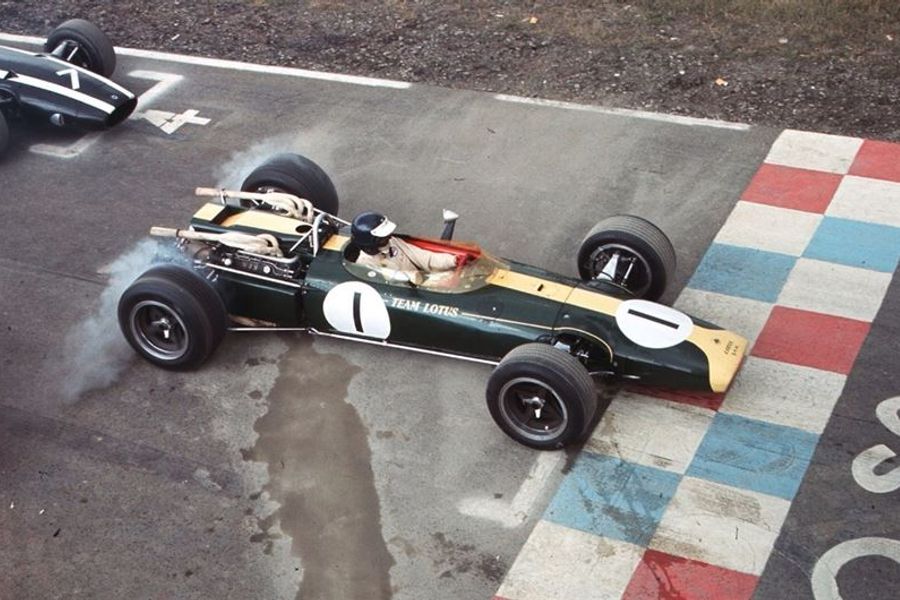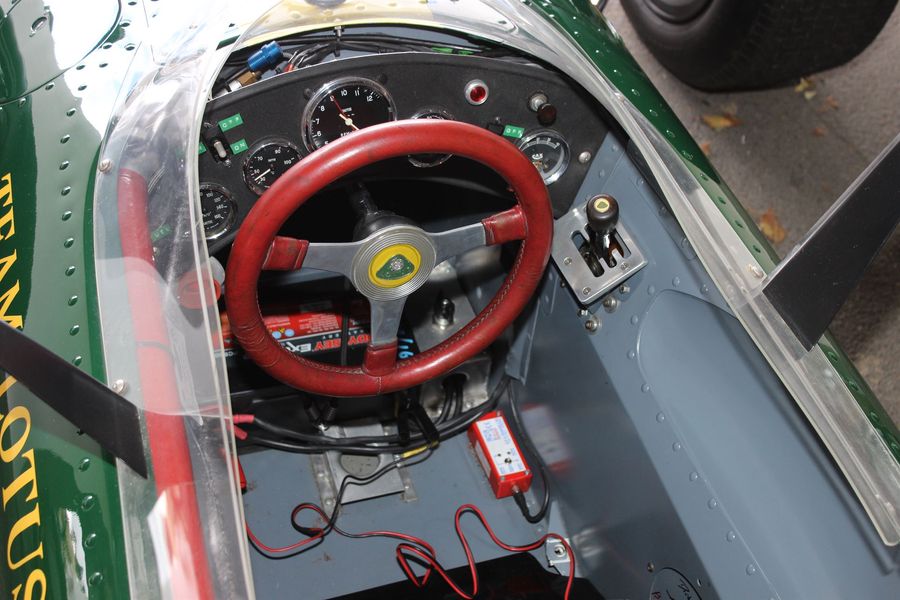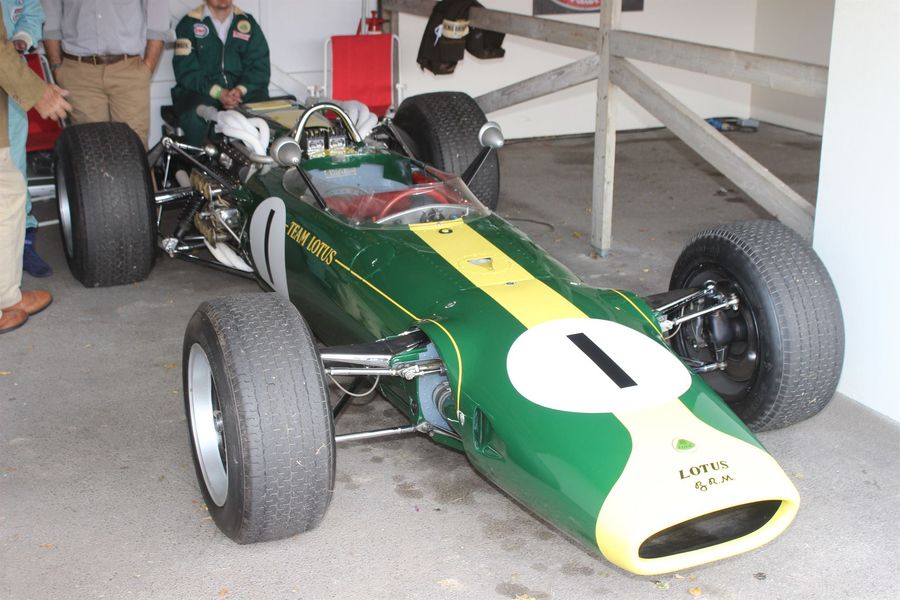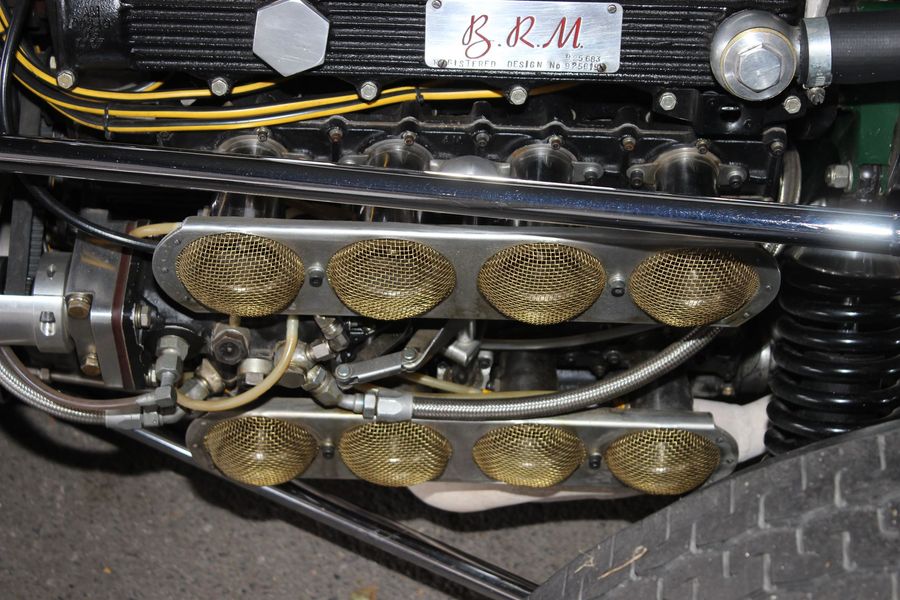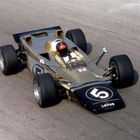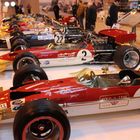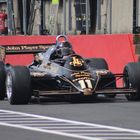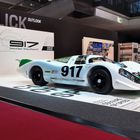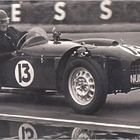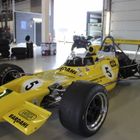Click on the Gallery tab for images of the Lotus 43 at the 2016 Goodwood Revival, and the Video tab for footage of an impressive engine start up at an earlier Revival!
One of the more unusual historic Formula One cars is Andy Middlehurst’s Lotus 43, which features the innovating BRM ‘H16’ layout engine that was the British manufacturer’s response to the change in Formula One’s engine regulations for the 1966 season. With the Lotus team in need of a three-litre engine they choose to use the BRM unit, and despite only racing their new car in the second half of the season, Jim Clark gave the H16 its only race win in that year’s American Grand Prix.
Having been unused for many years Andy’s car had to be painstakingly rebuilt and the complex engine nursed back into action, and now it is used for demonstration runs such as at the recent Oulton Park Gold Cup meeting and the Goodwood Revival’s ‘Return to Power’ themed track display – Andy feeling that the car would not be competitive in historic racing against the more developed three-litre Formula Ones cars that followed it.
“I think you have to be brave to take on a car like this,” said Andy, “it had been in the back of a lorry for many years when we bought it, we had to rebuild it and now we use it for displays. The only way to find an expert on the BRM H16 engine is to become one yourself, we were able to find out some information from ex-BRM staff, plus a university did a technical study of it a while ago, then we just learnt from rebuilding it ourselves and have got it to be reliable.
“The engine feels very different to a V8 Climax from the season before that was all about keeping the revs up for power, it is very torquey and pulls well from 4,000rpm and has a flat power curve right up to 9,500rpm. You don’t have to be changing gear all the time, we had a gearbox problem at Oulton Park recently and I went round the whole lap quite happily in just fourth gear.
“The car won one Grand Prix back in 1966 and was started on the front row of two others so it could be quick, it was just the reliability and the tight timescale that caused them problems. It’s a heavy and complex engine, and I think that sheer complexity was the problem for them back in the day.
“It was a real labour of love to get the car going, you had to be a real enthusiast to take it o and we had to track down lots of information about a car that was just used for half a season before they moved onto the Lotus 49 with its Cosworth DFV engine, even the mechanics soon forgot what was on this car. We had to talk to them and rekindle their memories, and it took us over eight years to get the car from how it arrived to how you see it now.
“We didn’t want anyone to be able to say that it didn’t look original so did a lot of research right down to paint colours and how it looked at races. As far as I am aware there is nothing on the car that wasn’t there when it raced in the day.”
Race car and engine manufacturer BRM built the H16 engine in response to the Formula One rule change for the 1966 season that saw engine capacity increased to three litres from 1.5. Declining one suggestion to build a V12 engine, BRM opted to make the H16, which was essentially two ‘flat’ V8 engines mounted one above the other, with the crankshafts geared together to make a common drive output.
The resulting powerplant proved to be powerful, but also heavy and due to its complexity unreliable. Motor racing legend has co-designer Tony Rudd insisting that drawings were not followed accurately on the cast components and that they were thicker – thus heavier – than specified.
BRM had their new chassis, the P83, ready to run the engine for the start of the season and it appeared in practice at Monaco in the hands of Graham Hill, and then Jackie Stewart tried it at the second round in Spa, but on both occasions it was a two-litre V8 powered P261 that they raced. It was Monza in early September before the team raced the H16 in an actual Grand Prix, both drivers retiring from that race, and the two remaining rounds of the year.
Lotus opted to use the engine and built the new Lotus 43, developed in part from the Lotus 38 Indianapolis car as a stronger chassis able to deal with the power increase was required. Their first run with the car was in practice at Spa in June, but Peter Arundell did not race, and then he retired with a gearbox issue in the French GP at Reims.
For a while the team reverted to the Lotus 33 with a two-litre BRM V8, but team-leader Jim Clark was out in a 43 at Monza, where he retired, but then took a win at Watkins Glen in the next race – the only Grand Prix victory for the innovative engine and the Lotus 43. Clark had intended to use the V8, but a change in the prize money system for the race, which saw $20,000 on offer to the winner, saw him use the powerful 43 in practice to be second quickest, although late in the final session the engine let go and the team had to borrow BRM’s spare.
As the race approached Clark was still undecided as to which car to race, but chose the 43 and was running third in the early laps behind Ferrari’s Lorenzo Bandini and Jack Brabham. John Surtees got past and into third but went off as the lead trio caught Arundell to lap him, the first two going past but Surtees behind for several corners before the two cars touched and both went off onto the grass.
Bandini lost his engine while leading on lap 34, handing the lead to Brabham who had a good advantage over Clark, but the Australian’s Repco V8 then also blew on lap 55, putting Clark into the lead with a minute’s gap back to the Cooper-Maserati of Jochen Rindt. Clark took the flag after the 108-laps, Rindt running out of fuel on the final lap and having that lap discounted due to how long it took – so he was credited as second but a lap down ahead of Surtees.
Lotus used the 43 in the opening race of 1967 at Kyalami before reverting to two-litre V8 power before the fable DFV came along for the Dutch GP, while BRM plugged away with the engine, though the drivers did revert to the two-litre V8 at some circuits, the only highlight a second for Stewart at Spa in June. For 1968 BRM themselves switched to V12 power, bringing the fascinating H16’s era to an end.
Lotus 33
V12 engine
Cosworth DFV engine
Jack Brabham
Graham Hill
Peter Arundell
two-litre BRM V8
American Grand Prix
Lotus 49
Ferrari’s Lorenzo Bandini
Lotus 38 Indianapolis car
Jochen Rindt
Monaco
John Surtees
French GP at Reims
Jackie Stewart
Oulton Park Gold Cup
co-designer Tony Rudd
V8 Climax
1967 at Kyalami
Spa
Repco V8
Cooper-Maserati
Lotus 43
Monza
Video Andy Middlehurst’s Lotus 43
2016 Goodwood Revival
Jim Clark
Gallery
BRM ‘H16’ Formula One’s engine regulations for the 1966 season
Popular Articles
April 2025 Podcast: Eddie Jordan, Much Missed Maverick
March 2025 Podcast: Targa 66, Race Retro, Scalextric and Famed Journo Pete Lyons!
February 2025 Podcast: Brian Redman, the First Daytona 500, the Pick of the Ecclestone Collection and so Much More!
January 2025 Podcast -Indy Collection, Daytona and Baghettii's Debut F1 Win!



